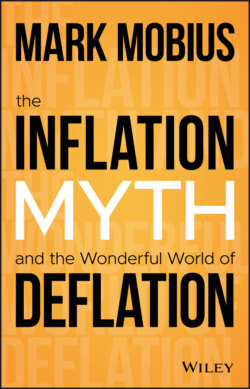Читать книгу The Inflation Myth and the Wonderful World of Deflation - Mark Mobius - Страница 17
The Urge to Debase
ОглавлениеGovernments’ urge to increase the money supply predates the invention of paper money. The idea of coinage is sometimes dated back to the eighth century BC, and their use in Lydia in Asia Minor (modern Turkey). Here, a combination of abundant gold and developments in metallurgy combined to create a system of standardized gold coins. Over the following centuries, the practicalities of using coins in comparison to bullion saw its use spread. But as coinage came into common usage, it wasn't long before governments sought different ways of manipulating the currency for their own gain. Rather than the purity of the earliest gold and silver coins, governments would order the reduction of the value of precious metals, debasing them with other metals or reducing their weight.
In the fourth century BC, Dionysius, the tyrant of Syracuse, who ruled a Greek colony on Sicily, had the brainwave of dealing with rising debts by changing the face of all the local Drachmae. Ordering all coins to be handed in, he restamped each single Drachmae to be worth two (and thus halved his debt at a stroke). He then went on to issue a further set of tin coins, insisting these were valued the same as the silver Drachmae.
Dionysius’ actions are the earliest, or at least one of the earliest, examples of a ruler increasing the money supply for their own ends. Back in China, Wang Mang's short reign as the thirteenth Emperor of the Western Han Dynasty (or the founder of the Xin Dynasty, depending on which historical view you take) was dominated by his economic reforms.
Wang Mang became Emperor in AD 9, but had been acting Emperor for two years before this – the emperor proper, Emperor Ping, was a young child. Wang Mang took advantage to take over as emperor himself. Wang Mang's reign was short (he died in AD 23) but he immediately set about enacting some serious monetary reforms. In the early years of his reign, he nationalized gold and ordered people to hand it in, in return for his new coinage. All private coinage was banned with prison sentences for those who used it. Later on, even those who knew people were using other coinage but didn't report it were imprisoned (as many as 100,000 people were imprisoned under these rules).
As for Wang Mang's own currency, these new coins were markedly debased compared to what they were replacing: in terms of gold, they were worth almost half as much. Added to this, the number of different coins in Wang Mang's scheme was bafflingly complex: there were 28 denominations of coins in total. According to He Liping's account, these actions were less to do with reducing debt than about shoring up Wang Mang's political position at the expense of wealthy nobles. While he might have had some success there, inflation soon followed, as much as can be deduced from the surviving documents of the time: the price of rice rose four times in a year, for example. And despite Wang Mang's best efforts, his subjects stopped using the official currency, instead returning to gold and the coins of the previous regime.
